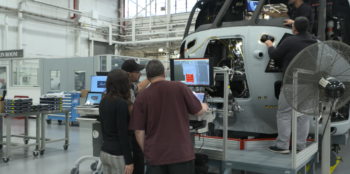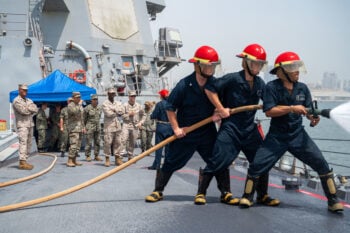
A Beriev A-50 takes part in rehearsal for 2020 Victory Day parade, in Moscow’s Tverskaya Street, Russia on June 20, 2020. (Sefa Karacan/Anadolu Agency via Getty Images)
FT. LAUDERDALE, Fla. — Earlier this month British military intelligence officially confirmed the mid-air explosion of a Russian A-50U surveillance aircraft, which Ukraine says it shot down — in what would be the first downing of such an aircraft in the 21st century.
The Jan. 14 downing of the A-50U, which was reportedly knocked out of the sky around the same time as an Ilyushin IL-22 combat control aircraft, came just days after the Brits said Russia was increasingly putting the command and control planes at risk to gather vital intelligence for targeting Ukrainian air assets and radar.
It’s a loss to Russian forces that Ukrainian defense industry sources and Western experts say will be difficult, if not impossible, for the Kremlin to replace in the near-term due to the relative effectiveness of Western sanctions on some key tech. One source told Breaking Defense a brain drain of radar engineering specialists since the outbreak of the war is also certain to hamper Russia’s efforts in replacing the specialists reportedly killed.
Jacob Mesey, who is part of the Washington-based Atlantic Council’s Forward Defense Program, told Breaking Defense that the “A-50U variant has been used to plug gaps in Russian radar coverages and quarterback for Kinzhal missile strikes on Ukrainian cities.
“This loss will be difficult to replace due to the number of hardware ‘black box’ sets in the A-50U version of the aircraft produced by Intel and other Western manufacturers,” he said. “These are required for the digital on-board electronics systems but are blocked for sale to Russia by sanctions regimes.”
Still, another specialist at the thinktank, Kimberly Donovan, warned that Russia has proven adept at skirting some sanctions, and said the US government must do more to “focus on enforcement of export controls and financial sanctions to ensure Russia cannot gain access to the components it needs to replace these aircraft.”
There are only a few of them out there, after all.
Shrinking Assets
The A-50U, which NATO dubbed MAINSTAY, “is a key enabler for Russian operations over Ukraine, providing airborne and early warning of threats as well as command and control functionality,” according to British intelligence.
There are currently conflicting reports of how many A-50U aircraft the Russian air force (VKS) has at its disposal. The confusion is partially due to different variants of the aircraft still in operational status.
But by scouring Ukrainian- and Russian-language online resources, as well as some scant English-language media reports, it appears there were around 30 — or as many as 40 — A-50s produced in the Soviet era, though only about a dozen are believed to still be in operation worldwide.
A handful have reportedly been upgraded to the most current A-50U configuration. Three others were sold in an export configuration to the Indian Air Force, according to Russian media. Most of the remaining were sent to the boneyard over the years.
If some of the remaining older A-50 air frames could be cannibalized, a smaller number could theoretically be modernized to the A-50U configuration. But sources in Ukrainian defense industry familiar with the defense electronics sector in Russia discount that possibility.
They point out Russian industry has been unable to produce more A-50Us in the past several years — even before the war. This inability of Moscow’s defense industrial base to expand the fleet or replace those shot down had made the VKS unwilling to risk their loss in combat, at least for a time.
Additionally, the A-50U carries a hefty price tag of £274 million ($330 million), a valuation previously reported in February 2023 when an A-50U was severely damaged in a drone strike while parked at Machulishchy aerodrome in Belarus. This is also a sum difficult for Moscow to mobilize at a time when its revenues from oil and gas exports are contracting as much as 41 percent.
In the case of the IL-22M and IL-22PP models, the VKS had 30 of these in operation at last report, but those numbers do not include either the aircraft shot down by the Wagner Group or the 14 January shootdown.
Russian difficulties do not end with the inability to produce replacement aircraft. Another specialist who spoke with the Ukraine State Information Agency (UNIAN) said that the VKS also have a pronounced personnel problem.
The A-50U aircraft has a flight crew of five, and these “can be easily replaced. Any Il-76 flight deck crew can be trained to fly the A-50 in about two months,” said Valeriy Romanenko, a rector at the Ukraine National Aviation Museum. However, the 10 to 11 operators who sit in the back and man the tracking stations linked to the radar and the aircraft’s other sensor packages are another matter.
“These specialists take years to train and this is indeed a serious loss for the enemy,” Romanenko reportedly said.
Reports Of A Ukrainian Trap
As for how exactly the A-50 was taken out in mid-January, beyond claiming the shootdown, the Ukrainian military has offered scant details. Some observers have claimed the Russians accidentally shot the plane down themselves.
The Ukrainian military did not respond to Breaking Defense’s questions about the supposed operation, but in news reports, and in the minds of some observers, an intriguing possibility has presented itself:
Both the A-50 and the IL-22 were operating near the Azov Sea and intercepted within 10 minutes of one another. All collected evidence to date is the A-50U was hit while airborne, broke apart and crashed with all 15 on-board killed, while the IL-22 managed to make an emergency landing with a severely damaged plane.
That was the result, some reports and analysts have suggested, of a one-two deception by Ukraine’s air defense units utilizing a Ukrainian S-300 (SA-10) battery in concert with a US-made Patriot PAC-3 unit.
According to some reports, the S-300 crew likely switched on their radar until the emissions were reported by a VKS Su-34 fighter, which then notified the A-50U and IL-22M to vector towards those coordinates to gather targeting information.
The S-300 radar then provided the location of the Russian airborne targets and handed off that data to the Patriot crew. When the time was right, the Patriot crew switched on its radar for only a few seconds — an adequate interval to receive the S-300’s targeting data, but too short of a time for Russian receivers to identify the US-made system.
The Russian planes, lured in by the S-300, were then targeted by the Patriot system. Once the Ukrainian Patriot fired its missiles and hit their targets, both the S-300 and PAC-3 batteries shut down all radar transmissions and immediately moved from their position. This made it impossible for Russian aircraft to locate them from their emissions and strike back.
The move would be an example of the “shoot and scoot” type of operations that Ukrainian units have been carrying out since 2022. It would also demonstrate that the Ukrainian air force may be willing to risk placing one of its PAC-3 batteries closer than normal to the front lines.
If that’s how the operation was conducted, one Ukrainian defense industry official who does not have knowledge of the operation told Breaking Defense it would show that “the Ukrainians are able to take the risks in order to achieve this strategic victory over the VKS.”
“It shows we are not afraid to do what it takes to defeat the Russians in the air, on the ground, or at sea. It’s now their turn to be afraid,” the industry official said.
As for when another A-50 could find itself a target of Ukrainian aggression, it could be a while. In its mid-January release, British intelligence noted that another an A-50 had apparently replaced the one taken out on Jan. 14, “but this time over land within Russian territory … .”
“This activity is highly likely indicative of a reduced risk appetite for the airframes and an attempt to preserve remaining A-50 MAINSTAY at a loss to its overall effectiveness over Ukraine,” the Brits said.
TAI exec claims 20 Turkish KAAN fighters to be delivered in 2028
Temel Kotil, TAI’s general manager, claimed that the domestically-produced Turkish jet will outperform the F-35 Joint Strike Fighter.


























